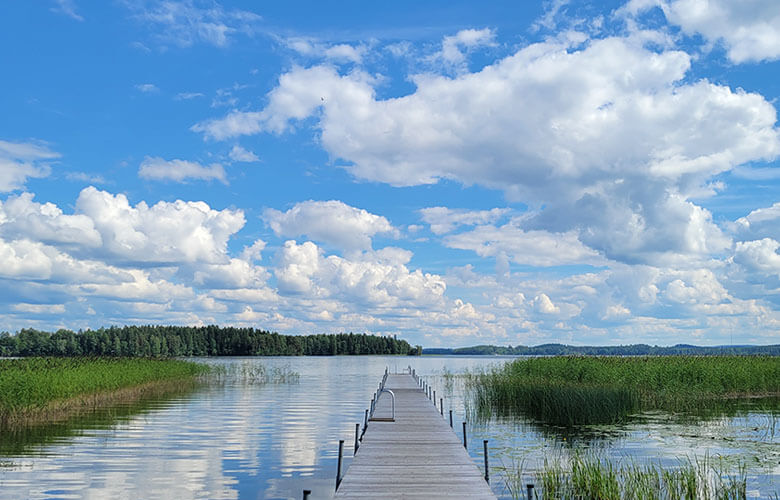Summer has arrived finally, and Finns look forward to enjoying the long summer days. After all, Finland, particularly in the northern part of Lapland, is one of the few parts of the world that enjoys the midnight sun.
Juhannus is the celebration of the summer solstice, or Midsummer, in Finland. Although many cultures around the world celebrate Midsummer, Nordic regions rever this holiday.
History of Juhannus
Juhannus was a significant holiday in Finnish paganism. The holiday corresponds with the summer solstice, which honors Ukko, the God of the Sky, Crops, and Fertility. Traditionally, pagan Finns lit kokkos (bonfires) near lakes to ward off evil spirits. These bonfires celebrate the dominance of the sun and honor Ukko. During this time, Finns would conduct rituals, divination, and dance to commemorate the day when the sun never sets. Celebrations of Midsummer centered around fertility, nature, and honoring Ukko.
After Christianity took root in Finland during the 11th and 12th centuries, the holiday was adapted to celebrate St. John the Baptist. From here, the name Juhannus came about to honor the Saint. Although the holiday was adapted to fit Christianity, many Finns still celebrated the old pagan traditions that founded Midsummer festivities.
In the early 1800s, Finland went through a Romantic period. Finnish nationalism grew in popularity exponentially. Eventually, this spawned Elias Lonnrot’s collection of Karelian rune-songs in the national epic Kalevala. In the Romantic period, Midsummer festivities adopted poetry, cultural pride, and retained many of the old folk celebrations.
In modern Finland, celebrations tend to center around family, friends, and celebrating the start of the summer. Many Finns enjoy spending time in the sauna, drinking, cooking, and swimming in lakes until the wee hours of the morning. Celebrations typically take place in a mökki (summer cottage). Family and close friends often meet together to ring in the festivities.
Importance of the Midsummer Celebration
After the long and cold winters filled with perpetual darkness, Juhannus became perhaps the most important holiday to Finns. This not only marks the start of summer but also emphasizes the importance of love and fertility.
In pagan times, unmarried women would conduct rituals or spells to glimpse their future husbands. In some rituals, a woman would lean over a well, naked with a charm, to witness the reflection of her husband. However, the more popular ritual entails placing seven types of flowers under a pillow to invoke a dream of a future husband.
Regardless of the old traditions, Juhannus is more popular than Christmas to some families. This unique holiday offers many Finns the opportunity to retreat to their mökkis and enjoy time with nature. Most mökkis are built on the banks or near lakes. This allows one to enjoy the forest and lakes, which ties deeply into the Finnish sauna culture as well.
Juhannus Traditions in Finland
Traditionally, kokkos, or bonfires, were lit near lakes to ward off evil spirits. Bonfires in the countryside are still common to this day. In major cities, some still celebrate this tradition with a city sponsored bonfire.
However, most Finns prefer to travel to the countryside, away from the bustle of the city. Mökkis are common, and most Finns have a summer house or know someone who does at least. Cities are often sparsely populated during Juhannus, and traffic is certainly lighter.
Saunas are imperative during Juhannus. Finns are the original inventors of the sauna. As such, it is deeply ingrained in Finnish culture. Vihtas are a collection of birch leaves tied together to create a bushel used for exfoliation. While in the sauna, Finns use these vihtas to flog parts of the body for enhanced circulation and exfoliation.
Fishing, cooking, and foraging are other typical summer activities. Finland has many wildberries, including elderberries, lingonberries, currants, blueberries, raspberries, and many more. There are about 37 edible berries that grow wild throughout the Finnish countryside. Jams are made with these as well and enjoyed with lettu, a thin pancake similar to a crepe.
Karelian pies are another food unique to Finland. This pierogi-style pastry consists of baked rye dough with a rice porridge filling. After baking, most people top this with an egg and butter spread.
Mämmi is another popular dish consisting of rye flour, water, malted rye, and orange zest. The result is a baked rice porridge with a flavor similar to molasses. Mämmi can be eaten alone but is often added to milk, cream, or sugar. This dish is also very popular as an Easter dessert.
Land of the Midnight Sun
Finland, like its neighbors Sweden and Norway, enjoys almost complete sunlight throughout the summer months. This is particularly present in the regions above the Arctic Circle.
Lapland enjoys 24 hours of sunlight for up to 2 months. While the capital of Finland, Helsinki, enjoys 19 full hours of sunlight between June 20th – 26th. However, even when the sun sets in Helsinki the sky appears like that of early dawn. Finns call this phenomenon “white nights.”
During Juhannus, many Finns celebrate the long-lasting days after the prolonged dark winter. White nights allow celebrations to continue into the early mornings. And it’s easy to lose track of time with the perpetual sunlight.

